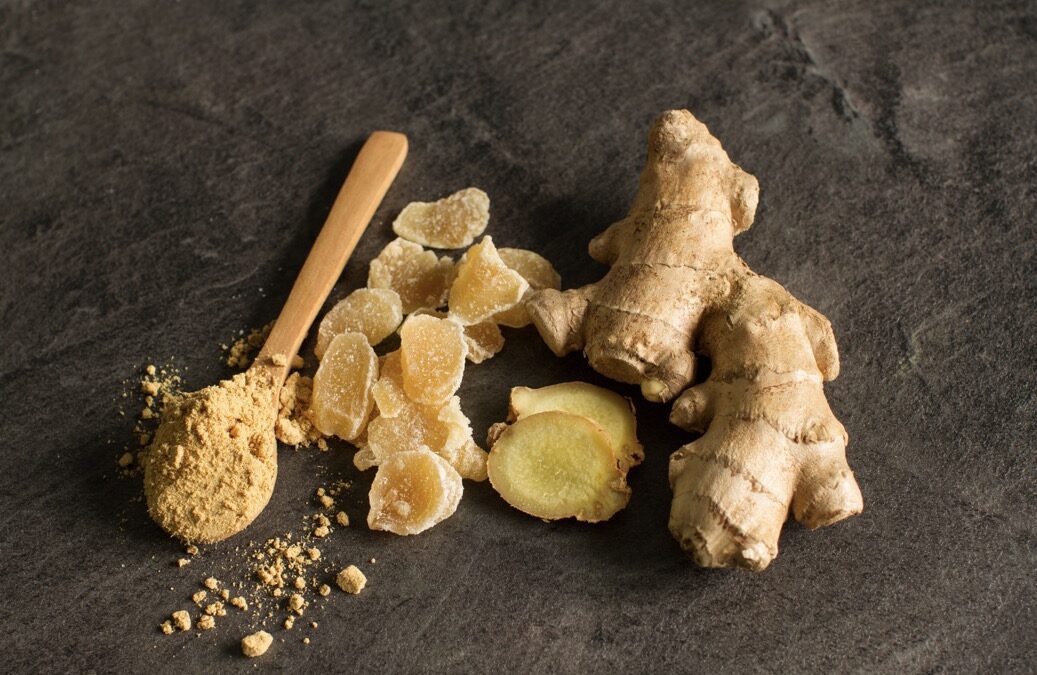Aside from being a zingy addition to many dishes, ginger has numerous health virtues. Asian traditional medicine systems have used ginger as a medicinal tonic for 5000 years. Ginger has undoubtedly stood the test of time.
The root, or more technically the rhizome, is the medicinal part of the plant. Ginger can be used either fresh or dried. The fresh root, either juiced or tinctured, is more potent than the dried.
Ginger is a warming, aromatic, pungent and stimulating spice, making it suitable for sluggish, damp, cold and cramped conditions. It gets fluids moving!
Anti-nausea
Ginger can help relieve nausea: morning sickness, chemotherapy-induced and travel sickness. Generally, you’ll need to take higher range doses for this. Capsules can be a practical alternative here.
Digestion
Ginger helps stimulate the flow of gastric juices, including saliva, bile and stomach acid. This makes it helpful in bloating, colic, gas and diarrhoea and irritable bowel syndrome. It also reduces spasms in the intestinal muscle.
I also find it an excellent prokinetic agent to help restore the migrating motor complex in conditions like small intestinal bacterial overgrowth – SIBO. (Take between meals for this effect.)
Studies have shown it can also inhibit certain strains of Helicobacter pylori.
Circulation
By reducing platelet aggregation, ginger can help “thin” the blood and improve the flow to the peripheral circulation. This is helpful for those with chronic cold hands and feet.
** If you’re taking blood thinning medication, check with your doctor before using high amounts of ginger.
Immune health
Ginger can help your immune system mount an effective response if taken at the first inkling of a viral infection.
As a heating spice, ginger helps you to mount a sweat. This helps manage a fever. For this, you need a hot decoction (tea) of the fresh root. Take every 2-3 hours until symptoms ease.
It can also be helpful for the aftereffects of a respiratory tract infection, shifting stuck mucus and helping resolve stuck mucus and postnasal drip.
Female health
I love ginger to support women who get painful menstrual cramps, especially the kind where you get relief from a heat pack.
During labor, it can be helpful to maintain the strength of uterine contractions.
Anti-inflammatory
Ginger has been successfully trialled to relieve pain associated with arthritis and compares favourably with NSAIDs with a much better safety profile.
How to use ginger
You can add fresh ginger to salad dressings, soups, stir-fries and curries. It makes an aromatic addition to fresh juice.
I like it as tea. Use six thin slices of fresh ginger or around 2cm grated and steep for 15-20 minutes. Ideally, cover it while you are steeping to retain the volatile oils. You can also buy ginger tea bags, but dried ginger will not be as potent as fresh.
Ginger is available in capsules. I use a concentrated tincture in the clinic, which can be a quick and convenient way of using ginger therapeutically.
Safety of ginger
Ginger has an excellent safety profile. Because of the taste, some will not find it palatable.
For pregnant women, don’t exceed 2g per day of dried ginger. Large doses may also irritate gallstones and should not be used concurrently with blood thinning medications unless supervised. Average dietary amounts should be fine.
Also, if you tend to run “hot”, ginger might be a bit too stimulating for you.
I hope that’s given you some insight into the many applications of ginger and the confidence to reach for it next time you need its spicy help!

Need help with your health?
Norelle Hentschel is an experienced naturopath with a clinic in Stones Corner, South East Brisbane and Telehealth consults Australia wide.
Want more articles like this?
Receive a monthly digest of natural health information to help you become “health” sufficient!
PS. Your inbox real estate is precious, and we will never annoy you with sales pitches or share your details with anyone else. One email a month — that’s it.

